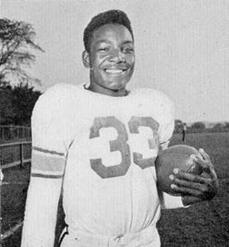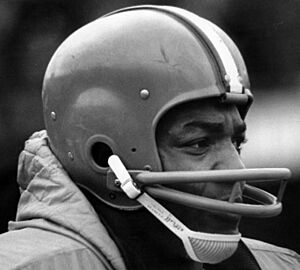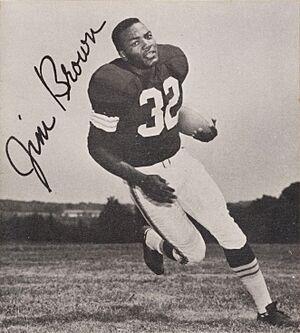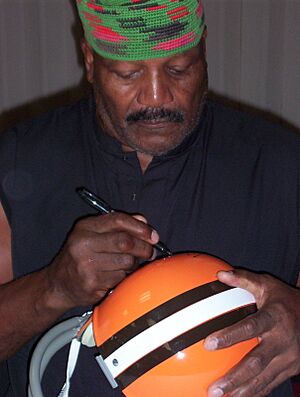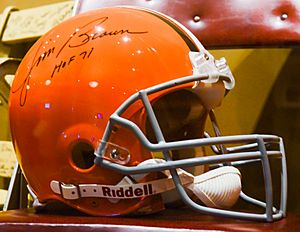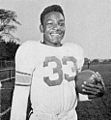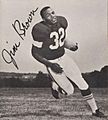Jim Brown facts for kids
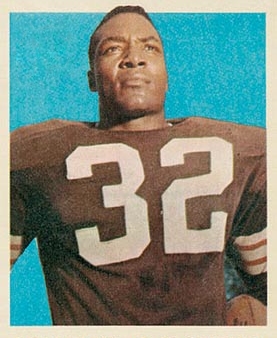
Brown with the Cleveland Browns in 1959
|
|||||||||||||||
| No. 32 | |||||||||||||||
|---|---|---|---|---|---|---|---|---|---|---|---|---|---|---|---|
| Position: | Fullback | ||||||||||||||
| Personal information | |||||||||||||||
| Born: | February 17, 1936 St. Simons Island, Georgia, U.S. |
||||||||||||||
| Died: | May 18, 2023 (aged 87) Los Angeles, California, U.S. |
||||||||||||||
| Height: | 6 ft 2 in (1.88 m) | ||||||||||||||
| Weight: | 232 lb (105 kg) | ||||||||||||||
| Career information | |||||||||||||||
| High school: | Manhasset (Manhasset, New York) | ||||||||||||||
| College: | Syracuse (1954–1956) | ||||||||||||||
| NFL Draft: | 1957 / Round: 1 / Pick: 6 | ||||||||||||||
| Career history | |||||||||||||||
|
|||||||||||||||
| Career highlights and awards | |||||||||||||||
|
|||||||||||||||
| Career NFL statistics | |||||||||||||||
|
|||||||||||||||
| Player stats at PFR | |||||||||||||||
|
Pro Football Hall of Fame
|
|||||||||||||||
|
College Football Hall of Fame
|
|||||||||||||||
James "Jim" Nathaniel Brown (born February 17, 1936 – died May 18, 2023) was an amazing American athlete, actor, and activist. He played as a fullback for the Cleveland Browns in the National Football League (NFL) from 1957 to 1965. Many people consider him one of the greatest running backs and overall players in NFL history.
Jim Brown was invited to the Pro Bowl every year he played. He was named the NFL's Most Valuable Player three times. In 1964, he helped the Browns win an NFL championship. He led the league in rushing yards in eight of his nine seasons. When he retired, he held many important rushing records. In 2002, The Sporting News called him the greatest professional football player ever.
Brown was also a fantastic college athlete at Syracuse University. He was an All-American in football and is considered one of the best lacrosse players of all time. The Premier Lacrosse League MVP Award is even named after him! He was also good at basketball and track and field.
In his professional football career, Brown ran for 12,312 yards and scored 106 touchdowns. These were all records when he retired. He is the only player in NFL history to average over 100 rushing yards per game throughout his career. He was added to the Pro Football Hall of Fame in 1971. His number 32 jersey is retired by the Cleveland Browns.
After football, Jim Brown became a successful actor. He starred in many movies, becoming one of Hollywood's first Black action heroes. He also worked hard for civil rights and helped young people avoid violence.
Contents
Early Life and School Sports
Jim Brown was born on St. Simons Island, Georgia. His father was a boxer, and his mother was a homemaker. When he was eight, he moved to Manhasset, New York.
He went to Manhasset Secondary School and was a star athlete. He earned 13 varsity letters in football, lacrosse, baseball, basketball, and track. He was known for being very self-reliant. In high school, he once averaged 38 points per game in basketball.
College Career at Syracuse
Jim Brown went to Syracuse University. He was the only African-American player on the football team as a freshman in 1953. He faced some challenges there, including racist comments.
As a senior in 1956, Brown was an All-American in football. He finished fifth in the Heisman Trophy voting. He set school records for rushing average and most rushing touchdowns in a single game (6). He ran for 986 yards and scored 14 touchdowns that year. In one game, he rushed for 197 yards, scored six touchdowns, and kicked seven extra points!
Besides football, Brown was excellent in basketball, track, and especially lacrosse. He was a second-leading scorer in basketball as a sophomore. In lacrosse, he was so good that some rules were changed because of how he played. He is in the Lacrosse Hall of Fame.
While in college, Brown was part of the Reserve Officers' Training Corps. After graduating, he became a second lieutenant in the U.S. Army Reserve and later became a captain.
Professional Football Career
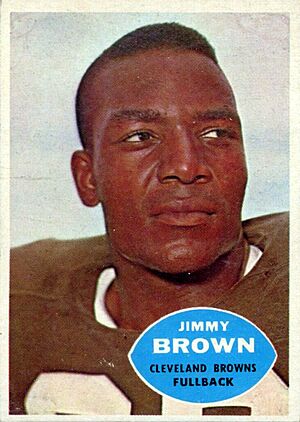
The Cleveland Browns picked Jim Brown in the first round of the 1957 NFL draft. He was the sixth player chosen overall. In his ninth game as a rookie, he rushed for 237 yards. This set an NFL single-game record that lasted for 14 years. It was also a rookie record for 40 years.
In 1958, Brown broke the single-season rushing record with 1,527 yards in a 12-game season. He also led all players with 17 touchdowns.
After nine years, Jim Brown retired holding many NFL records. He had the most career rushing yards (12,312) and rushing touchdowns (106). He was the first player to reach 100 rushing touchdowns. He also holds the record for averaging over 100 rushing yards per game for his entire career.
Brown was also a great receiver, catching 262 passes for 2,499 yards and 20 touchdowns. He was voted into the Pro Bowl every season he played. He scored three touchdowns in his final Pro Bowl game.
His 1,863 rushing yards in the 1963 season is still a Cleveland Browns record. It is the oldest rushing yards record for any NFL team. Brown led the league in rushing a record eight times. He was very hard to tackle, often needing more than one defender to bring him down. He was known for his strong stiff arm, speed, and power.
Jim Brown retired in July 1966 at age 30. He was still playing at his best. He was filming a movie called The Dirty Dozen in England. The team owner, Art Modell, threatened to fine him for missing training camp. Brown decided to retire instead. His career rushing record of 12,312 yards was broken by Walter Payton in 1984. Jim Brown is still the Browns' all-time leading rusher.
During Brown's career, Cleveland won the NFL championship in 1964. They were also runners-up in 1957 and 1965.
Acting Career
Jim Brown appeared in many movies. He was sometimes called a "black Superman" or "black John Wayne". He helped create more roles for Black actors in Hollywood.
Early Films and Leading Roles
Brown started acting before the 1964 football season. His first film was Rio Conchos (1964). In 1966, he filmed The Dirty Dozen, which led to his retirement from football.
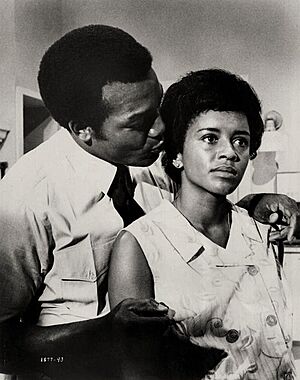
MGM gave Brown his first main role in The Split (1968). He then starred in Riot (1969). Both movies were successful. Jim Brown became known as the first Black action star.
In 100 Rifles (1969), Brown was the top-billed actor. He had a love scene with Raquel Welch, which was one of the first interracial love scenes in a major Hollywood movie. He became one of the highest-paid Black actors at the time.
Later Acting Work
In the 1980s, Brown mostly appeared on television. He was in shows like Knight Rider and The A-Team. He also had roles in movies like The Running Man (1987) with Arnold Schwarzenegger.
Later, he appeared in Mars Attacks! (1996) and Any Given Sunday (1999). In Any Given Sunday, he played a football coach.
Civil Rights Work
Jim Brown was one of the few athletes who spoke out about racial issues in the 1950s. This was when the civil rights movement was growing. He encouraged other Black athletes to get involved.
In 1967, Brown joined Bill Russell, Kareem Abdul-Jabbar, and Carl Stokes at the Cleveland Summit. They met with Muhammad Ali to support him. Ali was facing prison for refusing to join the military during the Vietnam War. Standing with Ali was risky for their careers. This meeting was a big moment for athletes using their voices for social change.
In 1966, Brown started the Black Economic Union (BEU). This group helped create business opportunities for minority-owned companies. He believed in building economic strength within the Black community. He said, "We've got to get off the emotional stuff and do something that will bring about real change."
In 1988, Brown started the Amer-I-Can Foundation. This organization helped young people at risk of violence. It taught them life skills. Through this foundation, he helped create the Watts truce between rival street gangs in Los Angeles.
The Federal Bureau of Investigation (FBI) watched Jim Brown and his organizations. They collected information about him.
Other Activities and Legacy
Jim Brown also worked as a color analyst for NFL football games on CBS in 1978.
In 1983, Brown thought about coming out of retirement to play for the Los Angeles Raiders. This was when it looked like Franco Harris might break his all-time rushing record. However, Walter Payton broke the record in 1984.
Brown was the first Black person to announce a televised boxing match in the United States in 1965. He also suggested a career in boxing promotion to Bob Arum.
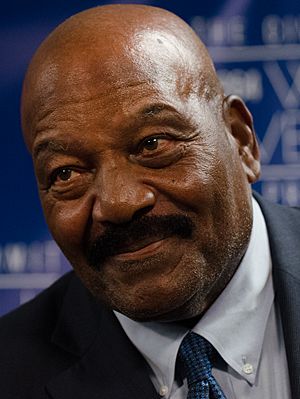
From 2008 until his death, Brown was an executive advisor to the Cleveland Browns. He helped build relationships with the team's players. He also became a part-owner of the New York Lizards lacrosse team in 2012.
In 2018, Brown met with President Donald Trump. He said that he met with the president because "we can't ignore that seat."
Personal Life and Passing
Jim Brown married Sue Jones in 1959. They had three children before divorcing in 1972. He later married Monique in 1997, and they had two children.
Jim Brown passed away on May 18, 2023, at age 87, at his home in Los Angeles. Many people from the sports world and beyond shared their tributes. NFL Commissioner Roger Goodell called him "one of the most dominant players to ever step on any athletic field." NBA star LeBron James said, "We lost a hero today. Rest in Paradise to the legend Jim Brown." Former President Barack Obama also honored him, saying, "One of the greatest football players ever, he was also an actor and activist."
Sporting Achievements
Jim Brown's amazing career led to him being inducted into the Pro Football Hall of Fame in 1971. His college football achievements earned him a spot in the College Football Hall of Fame in 1995. He was also inducted into the National Lacrosse Hall of Fame in 1983.
Brown is the only NFL player to average 100 rushing yards per game for their entire career. In 118 games, he averaged 104.3 yards per game and 5.2 yards per carry. Other Hall of Famers like Walter Payton and Emmitt Smith had lower averages. Brown held the yards-per-carry record for running backs from 1965 until 2012.
In 1999, ESPN ranked Brown fourth among their 50 Greatest Athletes of the 20th Century. Only Muhammed Ali, Babe Ruth, and Michael Jordan were ranked higher. In 2002, The Sporting News named him the greatest football player of all time. In 2019, he was chosen as one of the twelve running backs on the National Football League 100th Anniversary All-Time Team.
On January 13, 2020, ESPN named Jim Brown the greatest college football player of all time. This was during a ceremony celebrating 150 years of college football.
Images for kids
See also
 In Spanish: Jim Brown para niños
In Spanish: Jim Brown para niños


